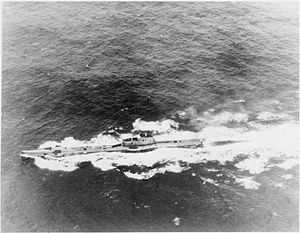HMS Triumph (N18)
 HMS Triumph | |
| Career (UK) | |
|---|---|
| Builder: | Vickers Armstrong, Barrow |
| Laid down: | 19 March 1937 |
| Launched: | 16 February 1938 |
| Commissioned: | 2 May 1939 |
| Fate: | sunk 14 January 1942 |
| Badge: |
 |
| General characteristics | |
| Class and type: | British T class submarine |
| Displacement: | 1,090 tons surfaced 1,575 tons submerged |
| Length: | 275 ft (84 m) |
| Beam: | 26 ft 6 in (8.08 m) |
| Draught: | 16.3 ft (5.0 m) |
| Propulsion: | Two shafts Twin diesel engines 2,500 hp (1.86 MW) each |
| Speed: | 15.25 knots (28.7 km/h) surfaced 9 knots (20 km/h) submerged |
| Range: | 4,500 nautical miles at 11 knots (8,330 km at 20 km/h) surfaced |
| Test depth: | 300 ft (91 m) max |
| Complement: | 59 |
| Armament: | 6 internal forward-facing torpedo tubes 4 external forward-facing torpedo tubes |
HMS Triumph (N18) was a T-class submarine of the Royal Navy. She was laid down by Vickers at Barrow-in-Furness and launched in September 1938.
Career
Triumph had a relatively active, yet tragic career, serving in the North Sea and the Mediterranean.
Home waters
On 26 December 1939, Triumph hit a German mine in the North Sea. Eighteen feet of bow was blown off and her pressure hull was also damaged, but fortunately the torpedoes in the torpedo tubes did not detonate. She managed to limp back home under the protection of fighter aircraft and destroyers, and was under repair at Chatham Dockyard until 27 September 1940.
Mediterranean
Operating in the Mediterranean from early 1941, Triumph sank the Italian merchants Marzamemi, Colomba Lofaro, Ninfea, Monrosa, the Italian auxiliary patrol vessels V 136 / Tugnin F, Valoroso, V 190 / Frieda and V 137 / Trio Frassinetti, the Italian tug Dante de Lutti and salvage vessel Hercules, the German merchant Luvsee, and the Greek sailing vessels Panagiotis and Aghia Paraskeva. She also damaged the Italian armed merchant cruiser Ramb III, the Italian tankers Ardor and Poseidone, the Italian merchant Sidamo and the German merchant Norburg
In June 1941 she sank the Italian submarine Salpa near northern Egypt.
Sinking
Triumph was also used for covert operations, such as landing agents in German occupied areas. She was planned to be used as a rendezvous for commandos in Operation Colossus, but this had to be cancelled when the landing site became untenable. She undertook one such mission in December 1941, in which she successfully landed agents in Greece. She was lost just over a week later, off Greece, probably to a collision with a mine in early January 1942. All fifty-nine crew were lost.[1]
There is a memorial to her and her lost crew members in All Saint's church, Lindfield, West Sussex.
References
- ↑ Submarine losses 1904 to present day, RN Submarine Museum, Gosport
- Colledge, J. J.; Warlow, Ben (2006) [1969]. Ships of the Royal Navy: The Complete Record of all Fighting Ships of the Royal Navy (Rev. ed.). London: Chatham Publishing. ISBN 978-1-86176-281-8. OCLC 67375475.
- Hutchinson, Robert (2001). Jane's Submarines: War Beneath the Waves from 1776 to the Present Day. London: HarperCollins. ISBN 978-0-00-710558-8. OCLC 53783010.
| ||||||||||||||||||||||||||||||||